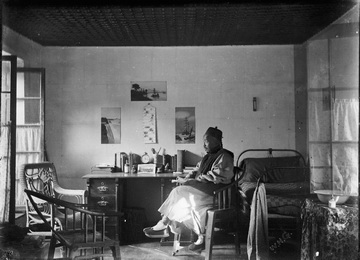Growing Collections: East Asian and South Asian Photography

Photograph of educated man in his study by W. H. Grant, gelatin silver print, China, c. 1900. ROM 2011.79.20. Gift in memory of Rev. Dr. William Harvey Grant and Dr. Susannah McCalla Grant, M. D.

View of Benares Ghat (temples on the banks of the Ganges River in present-day Vadodara), by S. H. Dagg, India, c. 1899. ROM 2011.79.1.37. Gift in memory of Rev. Dr. William Harvey Grant and Dr. Susannah McCalla Grant, M. D.
Last year, the ROM was given an important archive of 1,382 photographs and photographic material of China and India by the descendants of Rev. Dr. William Harvey Grant, a Presbyterian missionary and amateur photographer. He was stationed at a mission founded by the “Canadian 7″ in North China in an area called Anyang in Henan province, the last capital of the Shang Dynasty (1600 – 1046 BCE) and one of prominent Bronze-Age archaeological sites in China. From 1892 to 1937, Grant took photographs of the people and life around him in China and during his travels through India as a personal project. The archive includes albums, loose photographs, glass plate negatives, cellulose negatives, and postcards. Grant even saved the boxes and envelopes with the names of commercial studios around Asia where he developed his negatives! The quantity of material, high quality of individual images, and important history of the archive make it an excellent addition to the ROM’s growing collection of Asian photography. The collection is in the process of being properly housed in archival-quality storage materials so that it can be used in future research, publications, and exhibits.
Grant, of Rev. Alexander Grant of St. Mary’s, Ontario, was a gold medallist in Classics at Knox College (now part of a federation of seven colleges within the University of Toronto). Knox College theology produced a vigorous group of missionaries at that time and some went to the new mission in Honan province, North China. Grant went to manage the finances and organize. He was the long-term clerk and secretary of the mission. St. Catherines-based business man, William McCalla was the principal supporter of the Honan mission. Rev. Grant reported to him while home on furlough and met his daughter Susannah who had just received her MD. (U. of T. 1899) and was preparing for the mission field. Grant was delegated to escort her when he returned to China, but due to the Boxer Rebellion (1899) they were rerouted to India where they married. During their two year stay, Grant compiled an album of photographs from professional photography studios in India, which is also part of the collection now at the ROM. Susannah kept a private journal which is still with the family. They raised four children in China. Their daughter, Dr. Mary Hudson Grant Atack (University of Toronto, 1930) returned to China to practise medicine before returning to Canada prior to the Japanese invasion. Her daughter Susan Balfour, with her husband John Balfour, is the donor of the collection.
The Japanese occupation of China (part of the Second Sino-Japanese War, 1937-1945) made it difficult and dangerous for missions to continue. The Presbyterian mission in Anyang was shielded from the occupation for a time but closed in 1940. After retiring to Toronto, W. H. Grant was on the senate of the University of Toronto and in the Hart House Glee Club into his eighties. Susannah remained active in the Canadian Bible Society. James Menzies (who collected the oracle bones from Anyang dating to 1200 BCE now in the ROM’s collection) stayed at the same mission for a bit, overlapping with Grant, and can be seen in some of the photos.
